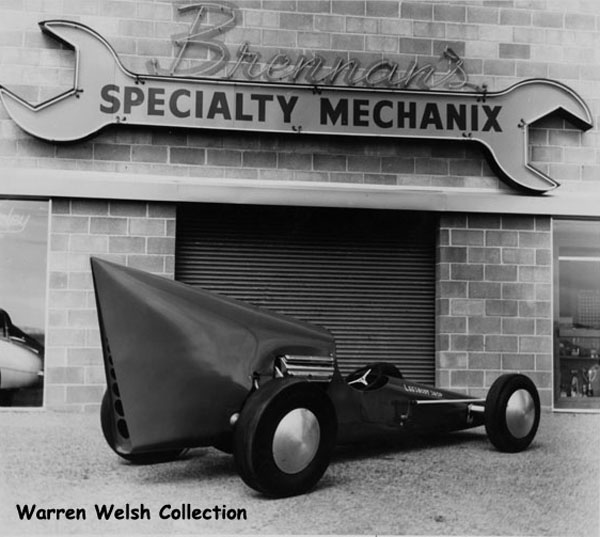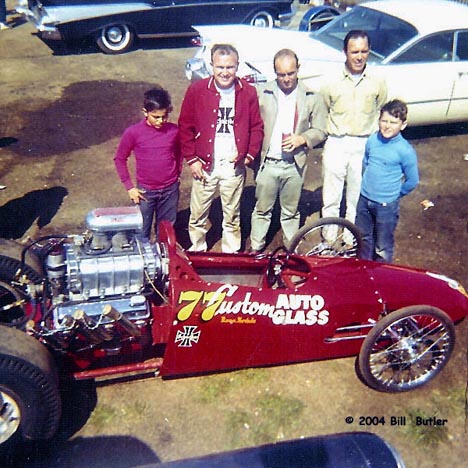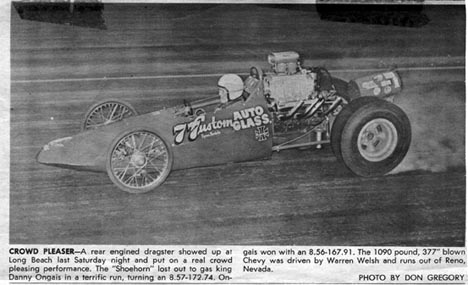Flyin’ Phil
Goes to the Indy 500 – Sorta…
by Phil R.
Elliott
A year or so after I was introduced to
Unlimited hydroplanes, I discovered Indianapolis. I was nine and it was a time
when real men in Tee Shirts drove Offenhauser-powered “roadsters” built by gods
named Watson, Kurtis and Kuzma. The live radio coverage was narrated by Sid
Collins and a host of others, all vocalizing to my imagination from high up
above those mystical straightaways and turns.
My favorite moments came
when historian Donald Davidson wandered into the announce booth to spread his
expanse of memories and minutia.
Each May, I pored over the scoreboard
section of the Seattle Post-Intelligencer for pre-qualifying, and pre-race
tidbits, always disappointed there couldn’t be more. It was over this lack of
coverage that, at about twelve, I called my first city editor.
I’m not
certain that I listened to the entire 1959 race, but I remember being both
excited and saddened by the announced lap times and the two deaths (Jerry Unser
and Bob Cortner). Roger Ward won the event, a man I would spend time with years
later when he headed the Circus Circus Unlimited team.
The next year,
1960, I was ready. I had read a couple books on the history of “the brickyard”
and knew names like Ray Harroun and Marmon Wasp. Behind Xmas and camp meeting (a
ten-day church activity each summer), Indianapolis in May was my favorite time.
There were no drivers killed that year, but a homemade grandstand collapsed
during the parade laps. Two people were killed and 40 others were
injured.
Roger Ward nearly won again, until on lap 197, his right rear
tire shredded. Jim Rathmann, who had previously been second thrice, blasted by
for the win. The two had put on a memorable battle.
Since I’ve always
liked underdogs, I loved it when the first of the (modern era) rear engine cars
arrived in 1961.
 |
| This is the restored Cooper-Climax Indy car just a couple years ago, photog unknown |
After finishing third at the
USGP (the final round that year was at Sebring) and taking his second Formula
One world championship, Jack Brabham tested at Indy in late 1960. I found it
interesting that all the Indy alumni scoffed at the strange little car with its
tiny 2.5-liter engine. When May arrived, the Brits arrived with a modified
version of the F1 car – the engine was bored slightly to bring it up from 152.5
to 165 cubic inches, qualified solidly and remained competitive all day. That is
still a lot less capacity than the 255ci Offys, plus they stuck to gasoline.
Brabham hustled the Coventry Climax-powered Cooper to as high as third and
finished ninth. By the end of the race that year, the announcers had made me
understand that the Cooper seemed to “handle” better than the stiffly sprung
front-engine roadsters. I listened intently. So did a few racecar
builders.
Though it was the lone rear engine design at Indy in ‘61, a
year that saw AJ Foyt win his first of four, Team Cooper gave a quick peek into
the future. A late race tire change on two-time pole winner (60 and 61) Eddie
Sachs’ Watson relegated him to a runner-up finish. Foyt and Sachs (who by this
time had become my favorite) had dueled through much of the race.
Though
not during the race itself, a May practice crash took "Tony" Bettenhausen’s
life.
I had already learned that racers made a dangerous
choice.
Rodger Ward won again in1962. He’d won in 1959, was second in
1960, third in 1961 and according to the Indy 500 record book, he eventually
became the only driver “to complete six consecutive races and never place lower
than fourth.”
Speeds were way up because the bricks were covered by a
skimcoat of asphalt. In fact, Parnelli Jones ran the first 150 mph qualifier
that year.
Back in the same car for 1963, Parnelli Jones was fastest all
month, setting a record qualifying speed (151.153 mph) and leading 167 laps on
race day. The win was not without its controversy as PJ’s Watson-Offy showed
smoke the final 25 laps. At least two drivers, (Sachs and Roger McCluskey)
protested they had spun in Jones’ oil.
But all the big headlines were
about a small group of cigar-shaped newbies. Englander Colin Chapman, owner of
Lotus, came with pushrod Ford power in the rear of the skinny racers, and one of
those, with Jimmy Clark driving, finished a close second.
During the
Monday press luncheon, “Sachs expressed his views (about the oil) a bit too
forcefully,” according to the Indianapolis Star, and Parnelli knocked him on his
butt!
Besides the Lotus-Fords, Mickey Thompson showed with a true hot
rod, a rear engine, wide, squat, aluminum Buick-powered machine rolling on
12-inch wheels/tires.
The rear-engine revolution continued in 1964, with
even some of the died-in-the-wool roadster builders fielding Offy-powered back
motors. Ford showed with DOHC versions of their small block V-8. The Fords ran
on gasoline that fueled a horrible and literal controversy – a lap two incident
that saw Sachs and Dave MacDonald burned alive in front of thousands of fans. It
caused a near two-hour delay and involved seven cars.
Indy had long been
a methanol-only arena, of course laced by nitromethane during qualifying. And,
following a major campaign by the Indy Star, gasoline was subsequently
outlawed.
A.J. Foyt’s second win was almost lost in the gas vs. methanol
and FE vs. RE fervor, but it will always be noted that his was the last
Indianapolis 500 victory by a front-engine car. The once ubiquitous roadsters
were being called dinosaurs. Rodger Ward and Lloyd Ruby followed Foyt across the
yard of bricks. The latter, following Sach’s death, would later become my
sentimental favorite, mostly because of his poor Indy luck.
The
inevitable came in 1965 when Scot Jim Clark, in only his third Indy start, led
190 laps to win by about two minutes! DOHC Fords, which had nine of the first
ten spots on the grid, also finished in the next three positions. The number one
car under the “Lotus Powered by Ford” banner had a secret ingredient. Chapman
hired the NASCAR Wood Brothers and their patented pit stop abilities which
helped in two ways. Not only did they get the 1963 F1 world champ out quicker on
each pit stop than anyone previously thought possible, their quickness also
confused seasoned veterans who were convinced the pit crew hadn’t gotten enough
fuel in the tanks! Even the radio announcers were certain Clark would
falter.
I haven’t mentioned the shrieking NOVI engines (1941-65) which I
could hear, even through my tiny transistor radio speaker. They were hugely
powerful – while they lasted. I always wished I could have seen/heard them in
person – boy were they loud! The last year a Novi ran at Indy was actually 1966,
but after Greg Weld wrecked during practise, the entry was withdrawn.
Can
you tell that by this time I was hooked?
Another Brit, 1962 F1 world
champion, “rookie” Graham Hill, won the 1966 500 in a Ford-powered Lola. The
race, according to the Indy Star, was, “the most fantastic, confused and
incredible 500.”
Another huge crash – sixteen cars – started that one.
Mario Andretti, who had really impressed as a rookie the previous year, was
highly favored but was forced out by an oil leak. Later, Ruby was leading by
nearly a lap but he too was black-flagged. Clark spun twice, both times while
leading. Jackie Stewart appeared to inherit the win but he lost oil pressure.
Clark’s team thought they’d won and were certain that when scoring went through
their double check, the unofficial result would be overturned. They even
protested, but the unofficial tally was not overturned. That had many saying
that “(Hill) never passed a car all day long.”
The next year was nearly
my favorite. It was 1967, and Andy Granatelli had gone a bit daft with a
turbine-powered, 4-wheel-drive entry that was long on engineering and
performance. It had been covered extensively in Hot Rod magazine and I was
certain it would win. It took off from row two, passing four cars in turn one,
and was really streaking when rains came. The next day, it did the same thing
again. I remember so well the track and event records the “whoosh-mobile” turned
in that day. About every ten laps, there was a new announcement of just how fast
that combination was pulling away from the rest. But, a few dollar bearing gave
up a few short miles from totally dominating for Parnelli Jones. I was so upset
I couldn’t eat all day.
Ford won again, to me a hollow victory for AJ
Foyt. He picked his way through a tremendous five-car crash on the front
straight for his third win.
Indy would continue to be a Ford playground,
winning five pole positions and six of the next seven race victories before
leaving open-wheeled competition at the end of 1971. All of the remaining DOHC
Fords were sold to AJ and they remained competitive for several years.
Turbines were restricted several times and they never won the Indy 500.
Neither did Lloyd Ruby.
When a Seattle theater showed the Indy-500 live,
I was part of the audience, and I was far from the only one that brought along
my transistor radio so I could stay in full contact with Sid.
Over the
many years hence, the race has maintained its romantic grasp on me throughout
its many incarnations, sanctions and evolvements. Of course, with all the other
motorsports available, Indy is no longer my pinnacle. But, even with dwindling
entry numbers and huge steps away from heritage, it still holds great
drama.
I’ve mentioned Standard 1320 several times over the years. It is a
loving group of curmudgeons, geezers and rapscallions that live drag racing,
especially 50s and 60s dragsters. One of these guys is Walt Huff who played a
pretty large part in Reno-area drags, and he mentioned to me in passing that a
few of his cronies got together once in awhile to bench race and swap lies
(Would that be redundant?). One of the annual get-togethers is for a pre-Indy
500 party. It was to be held at the Reno home of Warren an Evelyn Welsh on May
22.
Warren drove a little rear-engine gas dragster called Shoehorn back
in the late 50s and early 60s of which I’d seen a number of pictures. I called
to see what I (as a vegetarian) could bring but Warren told me all was
handled.
 |
| A Drag News caption once called the Welsh & Tyler "fin" car as "the most novel machine in California and Nevada." The Chrysler powerplant drove into a late 30s Cord front drive transaxle which maintained independent suspension for better bite. It also had a NOVI supercharger and Miller Indy car dual Pittman arm steering. From the few pictures I've seen and the descriptions by its builder, the car was well engineered. Warren Welsh Collection, Eric Rickman Photo |
The morning of the event, I took my car
for service and Walt Huff picked me up at a nearby mall. When we arrived, I was
introduced to those already there and the others as they arrived. There were the
Welshes, Brent Tyler, Roger McDunnah, Ray and Lisa Craft, Rick and Fran Reid,
Charlie (?). The home is lovely, and Walt placed a couple dozen prints of the
many racecars represented by the group on a large pool table. The Tyler &
Welsh "fin" car and Shoehorn were certainly the most prevalent, but several
others were among them as well. I noted “Bonanza”, the former
Greer-Black-Prudhomme that Welsh had driven to some success.
Dave Wallace
Jr., another invited outsider like myself, brought along a few goodies,
including the never circulated dragrace movie, “Seven Second Love
Affair.”
Then, lunch was served. It consisted of trout, freshly pulled
out of Lake Tahoe by Welsh the day before, and a few other items. Then came the
Indy 500 drawing. Everyone present threw $20 into a bowl, then drew a number
from another – I grabbed #4 meaning I
 |
| There you can actually see my draws. |
would get
fourth pick each time the next bowl circulated. That one held all 33 Indy
qualifiers. From that one, I drew Vitor Meira (6Q. finished 10th), Eddie Cheever
(19Q, finished 13th) and Thiago Medeiros (33Q, finished 31st). The rest did the
same. Whoever drew the winning driver earned the
loot.
 |
| Warren Welsh drove the extremely competitive Shoehorn in west coast competition. This shot, taken at Stead AFB, aka Reno Dragway, aka Lemmon Valley, was taken on the car's last run. Warren Welsh Collection, photog unknown |
Many more stories were shared. My favorite
was one Warren shared from about 1963, when a familiar face walked up to him
while he was in the staging lanes at Bakersfield. At the time, the team was
running the Shoehorn Ghost, a fairly typical sbChevy-powered FED. The guy asked
if he’d been the guy who had driven the original Shoehorn, then what it had run
as its best times. Warren told him that during a matchrace at Lions against
Danny Ongais, the car had run an 8.57/179, but had also run over 180mph on
several occasions. The guy than asked what the wheelbase had been. The answer
was “88 inches.” The guy walked away, shaking his head. It was Tony Nancy, who
at the time was in final construction phases with Kent Fuller on his rear engine
“Wedge.”
 |
| That's Bill Butler, Jim Cistone and Ray Craft with the little Shoehorn. Bill Butler Collection |
The party pretty well broke up after that
though several of us stayed to watch a DVD of the Mickey Thompson 200 MPH Club
race at Lions in 1966, and the Seven Second Love Affair. It was a wonderful
afternoon with a group of people I might never have met. I am grateful for the
opportunity.
No, I did not win the pot. Sam Hornish won the race from the
pole in a very exciting race, maybe the most exciting in recent history. But the
whole 2006 experience has added another really great memory to my mental Indy
500 scrapbook.
Just in case you wondered, I do indeed have a great
recollection for this stuff but to fill in the blanks, I used www.indy500.com.
 |
| Thanx to Walt Huff for sending me some of these images. |
Have a comment on this story? Click
HERE!